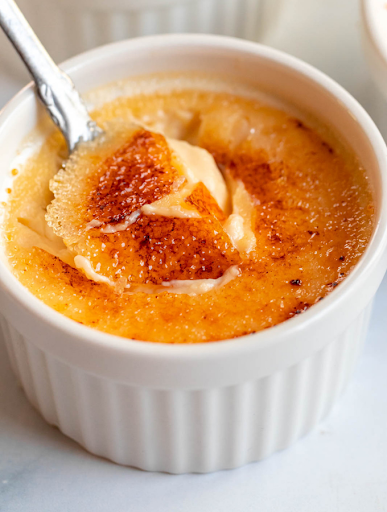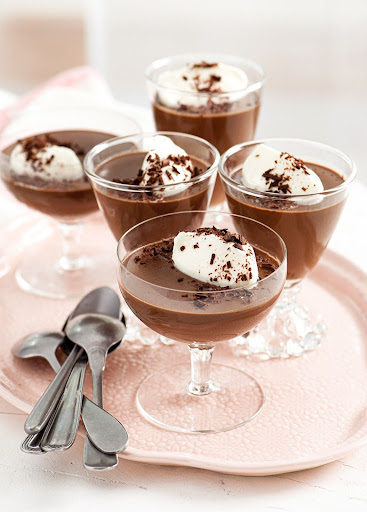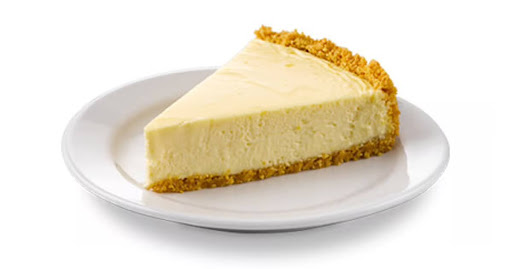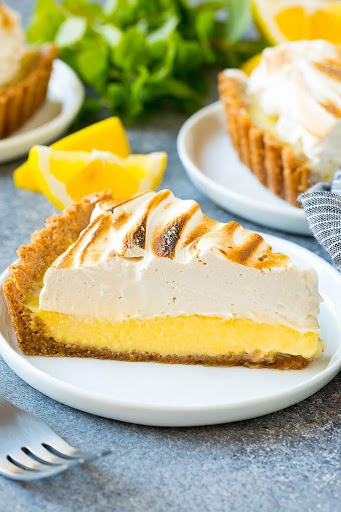Culinary School Secrets: How to Perfect Every Type of Custard
Hello Chefs,
Today in culinary school, we dove headfirst into the silky, smooth world of custards. If you’ve never made one before, let me tell you—you’re missing out. Custards are like the velvety superheroes of the dessert world. They can be creamy, light, dense, or practically melt-in-your-mouth, all depending on how you treat them. And we got a taste (literally) of just how versatile they can be.
We covered five main types:
1. Crème Brûlée

The icon of custards, crème brûlée is that perfect balance of creamy richness and crunchy caramelized sugar. The custard itself is made primarily of heavy cream, egg yolks, sugar, and vanilla, and it’s gently baked in a water bath to keep it luxuriously smooth. What makes crème brûlée special is that final moment of torching a layer of sugar on top to get that iconic, glass-like crust. It’s pure satisfaction to tap your spoon through that crisp layer and sink into creamy goodness.
Crème brûlée is considered a “stirred custard,” meaning the proteins are gently coagulated over low, indirect heat, resulting in that smooth, spoonable texture.
2. Pot de Crème

If crème brûlée is the glamorous showstopper, then pot de crème is its quiet, elegant cousin. This French classic translates to “pot of cream,” and it’s exactly that—rich, smooth, and velvety, served in little pots or cups. The base is similar to crème brûlée, with cream, egg yolks, and sugar, but it’s typically less sweet and slightly lighter.
Unlike the creme brûlée, we didn’t need the oven for this custard—we made it entirely on the stovetop, which gives you a bit more control over the texture. It was a slow, gentle heating process with constant stirring to prevent scorching, and the result was pure, spoonable perfection. Think of the silkiest chocolate pudding you’ve ever had, but somehow even more luxurious.
3. Flan

Flan is where things get interesting. Unlike the thicker textures of crème brûlée and pot de crème, flan is soft and jiggly—a true definition of “custard wobble.” Flan is made with milk, eggs, sugar, and vanilla, and the magic comes from the layer of caramel that’s poured into the mold before the custard mixture is added. When you flip it out onto a plate, the caramel becomes this glossy, syrupy topping that’s as gorgeous as it is delicious.
The key difference? Flan often uses whole eggs, which gives it more structure and that satisfying jiggle when you serve it. It’s also cooked at a slightly higher temperature than crème brûlée, which helps it set more firmly.
4. Cheesecake

Surprise! Cheesecake is actually a custard. I didn’t know this before culinary school, but it makes perfect sense. At its heart, cheesecake is made of cream cheese, eggs, sugar, and sometimes sour cream or heavy cream. The eggs are what set it into that dense, creamy slice of heaven we all love.
The trick to perfect cheesecake? Water baths. Much like crème brûlée, cheesecake benefits from a water bath to prevent cracking and keep the texture smooth. The steam from the water bath keeps the cheesecake moist as it sets, avoiding that grainy texture that sometimes happens with overbaking.
5. Lemon Cream Tart

This one was a revelation. I always thought lemon tarts were just… well, lemon tarts. But it turns out, the lemon cream is actually a type of custard! It’s made with lemon juice, eggs, sugar, and butter, cooked gently over low heat until thick and creamy, then poured into a buttery tart shell. The result is smooth and tangy with just the right amount of richness.
Like the pot de crème, this custard is cooked on the stovetop and then cooled, rather than baked. The stovetop method allows you to control the thickening process with precision, so you don’t end up with curdled eggs.
The Techniques Behind the Magic
We also went through some key techniques that make or break a custard:
1. Tempering:
If you’ve ever scrambled eggs in your custard (I have, don’t judge), you know why this matters. Tempering is all about gently introducing heat to your eggs so they don’t seize up and turn your silky custard into sweet scrambled eggs. You whisk a bit of hot milk or cream into the eggs slowly before combining it all. Done right, it’s pure magic.
2. Water Baths (Bain-Marie):
This one was new for me. To cook custards evenly and avoid that dreaded curdling, you place your ramekins in a baking dish, fill it with hot water, and let the gentle heat do its work. It’s like a little spa day for your dessert. And honestly? I’m a little jealous of that treatment.
3. Nappé:
This is a technique that’s not just fun to say (nah-PAY) but absolutely crucial for stovetop custards. Nappé describes the perfect level of thickness for a custard—when it can coat the back of a spoon and you can run your finger through it, leaving a clean line. It’s how you know it’s ready to come off the heat. If you go too long, it’ll curdle; too short, and it’ll be soupy. Mastering nappé is like finding that sweet spot of perfection.
4. Straining:
One of the simplest but most effective tricks we learned was straining the custard mixture before baking. This removes any bits of cooked egg or lumps and guarantees that final, silky-smooth texture. There’s nothing worse than biting into a beautifully creamy custard and finding a little chunk of cooked egg. Strain it, and you’re golden.
5. Prevent Scalding with Sugar:
If you’re heating milk or cream on the stove for a custard, add half the sugar directly into it while it heats. It seems simple, but it actually helps prevent the milk from scalding. Apparently, the sugar increases the boiling point just enough to keep things smooth and steady.
6. A Vanilla Bean Trick You Need to Know:
This one blew my mind. When you’re using a vanilla bean in a recipe, you usually cut it lengthwise and scrape out the tiny seeds, right? Well, if you want to avoid those seeds clumping up when they hit your warm milk or cream, dip the whole vanilla bean into your liquid first before scraping. That little dip helps everything loosen up, so when you do scrape it, the seeds disperse smoothly and evenly. No more clumpy vanilla flecks!
Crème Brûlée Recipe
Here’s the classic crème brûlée recipe we used in class. It’s simple, luxurious, and guaranteed to impress.
https://www.dvo.com/mobile/cookn/recipe-share/?url=https%3A%2F%2Fapp%2Ecookn%2Dcloud%2Ecom%2Fapi%2Fv4%2Fviews%2Frecipe%3Faid%3D8761df6b%2D68b1%2D466b%2D8ea3%2Da3e7bedc08cd%26rid%3D95aa1e1c%2D6640%2D41f7%2D95f6%2Df9e75fb4d998
Until next time, keep it smooth and custard on!
 Brennah Van Wagoner
Brennah Van Wagoner
Weekly Newsletter Contributor since 2025
Email the author! brennah.oaks@gmail.com
